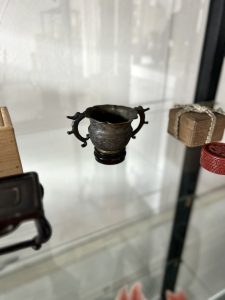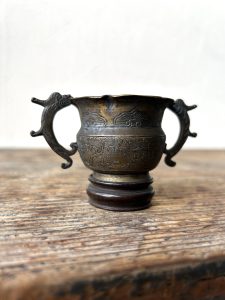見えない世界が広がっておりました(愛知県名古屋市千種区姫池通 骨董買取 古美術風光舎)
2023.12.20
皆さまこんにちは。スタッフHでございます。
昨日のスタッフTのブログを読んで、公言はできませんが一つ新しいことを始めました。良いとされることは実行し、悪いとされることは気にしないようにしております。
さて私、何度かお話しておりますが、小さいもの、ミニチュア物が好きで眺めるだけで楽しい気分になります。しかし視力がかなり衰え細部まで見えておりません。このガラスケースに並んでいる香炉も素敵な形だなぁと思っていましたが、実は何も見えていませんでした。


こちらは中国、明朝末から清朝時代に作られた銅製の龍耳香炉です。名前の通り耳と呼ばれる部分が龍の形をしております。恥ずかしながら最近気づきました。花びらの形の香炉の口をぱくっとくわえている表情が とてもユーモラスに見えます。背中の突起もデザイン性が高く、龍だと気づかなかった要因かもしれません。高さが5㎝ほどで遠目には全体的に黒っぽく見えますが、よく見ると緻密な絵が彫られています。もはや私の視力では見えないのでカメラの力を借りて覗いてみました。

木々や家々の他に、舟に乗った人、牛にまたがっている人、池に浮かぶあずまやで釣りをしている?人など、目を凝らさないと気づかない長閑な世界が広がっています。元々は仏具でしょうから何か絵に意味があるのか、どのような場面で使われていたのか妄想は尽きません。作られた当時に拡大鏡などなかったと思うのですが、どなたかの手の中で根気よく彫られたのかと思うと愛おしさが増します。
先日のスタッフYの蘭奢待についてのブログにもあるように、日本には「香道」いう芸道があります。その中で香りをかぐ作法を「聞香(もんこう)」といい、香りを聞くと表現します。中国語で香りをかぐという漢字は主に「聞」を使うため、てっきり香道は中国から伝わったものと誤解していました。れっきとした日本発祥の芸道なのですね。
日本最古のお香の記録は日本書紀に記されています。推古3年(595年)、現在の淡路島に流れ着いた大きな流木を島民が薪にし火にくべたところ、えも言われぬ香りが漂い、驚いて宮廷に献上したとされています。この流木は「沈水(沈香)」と名づけられたとのこと。東南アジアに自生するジンコウジュという木が倒れ、その切り口に分泌した樹脂が沈着し、水に沈むほど重くなったのが名前の由来だそうです。室町時代に武士の間で「香木」が好まれ、香りを楽しみ味わう「香道」へと繋がっていきます。鎮静効果に優れる沈香は、戦の前の高ぶる気持ちを鎮めるなどの役割を果たしたと言われています。
ところで中国語と日本語は共通の意味を持つ漢字も多いのですが、「聞」のように違う意味を表すこともあるので、かえって混乱を引き起こします。有名な例として、手紙=トイレットペーパー、他にも汽車=自動車、人間=世間、老婆=妻、丈夫=夫、暗算=密かに企む、などがあります。私が印象に残っている話があります。中国語の「空」には「そら」という意味はなく、空っぽ、空しいういう意味しかないので、日本の某航空会社の呼び名は中国人には実に奇妙に聞こえるとか。
かなり話が逸れました。失礼しました。
それでは、またお会いしましょう。
Hello everyone. This is Staff H.
After reading Staff T’s blog yesterday, I started one new thing, although I can’t say it publicly. I am trying to do what is considered good and not believe what is considered bad.
As I have mentioned several times, I like small, miniature objects and enjoy just looking at them. However, my eyesight has deteriorated considerably and I cannot see details. I was thinking that the incense burners in this glass case are also of a wonderful shape, but in fact, I could not see anything.
This is a copper incense burner with dragon ears made in China during the late Ming and Qing dynasties. As the name implies, the ears are in the shape of dragons. I noticed it recently. The expression of the mouth of the petal-shaped censer being snapped open looks very humorous to me. The protrusion on the back is also well designed and may be the reason why I did not notice it was a dragon. From a distance, the entire figure appears to be black, but upon closer inspection, one can see that it has been painted with great precision. I could no longer see it with my eyesight, so I took a peek with the help of my camera.
In addition to trees and houses, I noticed a person on a boat, a person astride a cow, and a person fishing in an azumaya floating on a pond. If you don’t look carefully, you won’t notice them. Originally, they were probably Buddhist ritual utensils, so there is no end to the fantasy about the meaning of the pictures and what kind of scenes they were used for. I don’t think there were magnifying mirrors when they were made, but I feel more affection for them when I think that they were carved patiently in someone’s hands.
As mentioned in the recent blog by Staff Y about Lanjatai, there is a Japanese art called “Kodo” (the art of incense). In this art form, the act of smelling fragrance is called “monko,” which means to hear the fragrance. In Chinese, the Chinese character for scenting is mainly “ken” (listen), so I had mistakenly thought that the art of incense was imported from China. It is, in fact, an art form that originated in Japan.
The oldest record of incense in Japan is found in the Nihon Shoki (Chronicles of Japan). In the 3rd year of Suiko (595), a large piece of driftwood drifted ashore on what is now Awaji Island, and when islanders burned it in a fire, they were surprised to find an indescribable aroma wafting through the air, which they presented to the court. This driftwood was named “agarwood” (agarwood). The name is said to have come from the fact that a tree called jinkoju, which grows wild in Southeast Asia, fell and the resin it secreted deposited on the cut end, becoming so heavy that it sank into the water. During the Muromachi period (1336-1573), “fragrant wood” was favored by samurai, leading to “Kodo,” the art of incense making, in which the aroma is enjoyed and savored. It is said that agarwood, which has an excellent calming effect, played a role in calming down the high spirits before a battle.
By the way, many Chinese and Japanese kanji share the same meaning, but sometimes they have different meanings, as in the case of “ken” (listen), which can cause confusion. Famous examples include: letter = toilet paper, train = automobile, human = world, old woman = wife, sturdy = husband, and dark = secret plan. There is a story that has left an impression on me. The Chinese word “Ku” does not mean “sky” but only “empty” or “empty”, so the name of a certain Japanese airline company sounds really strange to Chinese people.
I’m getting quite off topic. My apologies.
I will see you again.
*******************
ご実家の整理やお片付けなどをされている方のご相談などが多くございます。
お片付けなどくれぐれもご無理のないようになさってくださいませ。
風光舎では古美術品や骨董品の他にも絵画や宝石、趣味のお品など様々なジャンルのものを買受しております。
お片付けをされていて、こういうものでもいいのかしらと迷われているものでも、どうぞお気軽にご相談下さいませ。
また風光舎は、出張買取も強化しております。ご近所はもちろん、愛知県内、岐阜県、三重県その他の県へも出張いたします。
まずは、お電話お待ちしております。
愛知県名古屋市千種区姫池通
骨董 買取
【古美術 風光舎 名古屋店】
TEL052(734)8444
10:00-17:00 OPEN
#出張買取#骨董#古美術#骨董品#絵画#版画#茶道具#刀剣#彫刻

